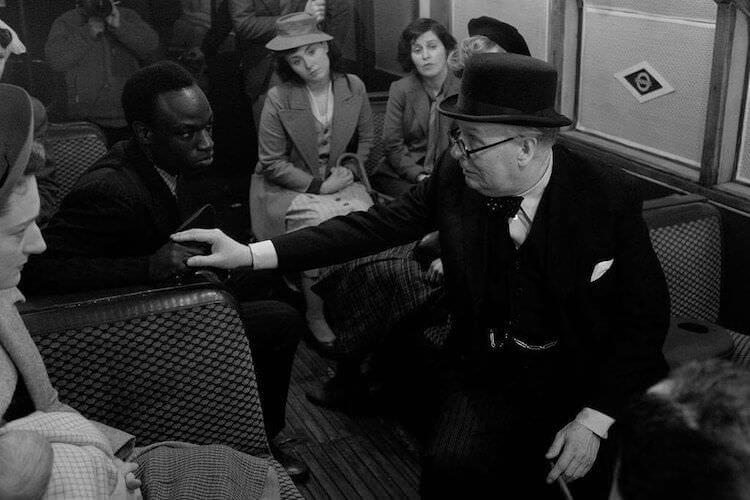Have you seen Gary Oldman in his interpretation of Churchill in the latest biopic by Joe Wright? If you have not, please go. It’s jaw-dropping. His outstanding performance may very soon win him an Oscar. You will enjoy some of the finest acting and also benefit from precious presentation lessons from the Master Orator.
Here are 3 takeaways from the movie, which you can immediately apply for your next keynote, sales meeting or investor pitch.
1. Sit down and listen.

© Working Title Films—@Working_Title
In one scene, likely fictional according to the critics, Churchill decides to go and meet the people.
He takes his first-ever ride on a London Underground train, and begins asking random citizens if they would fight the Nazis even if the odds were stacked against them? They reply in one clear, loud and vibrant voice: “Never surrender!”
There and then, Churchill’s decision to refuse peace talks with Hitler is strengthened. He rushes to deliver what will become one of his most powerful speeches, taking into account these citizens’ words, quoting them and even crediting them by name.
I loved this scene and frankly do not care whether it happened or not. In fact, it resembles the coaching advice I recently gave to the Senior Manager of an international company during one of our first sessions. As we explored the context of his annual strategy presentation, using Ideas on Stage methodologies like the ABCs (Audience, Burning Needs, Context), I gently guided him through a series of discovery questions. He soon realized he had only the vaguest sense of his audience: what was their experience? What did they most want and need from him in his speech?
“Why don’t you learn directly from your people?” I offered. Ask them. Wait. Listen quietly. Put yourself in their shoes. Thank them. And then reflect back.
So, during the Christmas holidays, he collected feedback and stories from his teams across Europe. In his talk, delivered before several hundred sales managers, he incorporated several personal stories that made the difference. “Wendy from the UK told me…, Karl from Germany…, etc.” He truly connected with his audience and showed them he cared.
“Courage is what it takes to stand up and speak; courage is also what it takes to sit down and listen.”—Winston Churchill
2. Prepare to sweat.
Maybe not blood and tears, but certainly sweat. In this movie, we see once again how Churchill literally perspires over the writing of his speeches. Even to the point of “steaming”. Just like Steve Jobs, Churchill was not a “born speaker”. And we believe no-one is.
He drafted his speeches many times over, until the very last moment. He dictated them to a secretary. Perhaps today he would use his iPhone to record himself and save some poor girl’s nerves. He then rehearsed passages, again and again, pacing up and down his room, repeating them aloud, learning whole speeches by heart.
As we coach CEOs, start-up entrepreneurs, doctors and TEDx speakers, we are often asked: “How long will the preparation last? How many sessions will it take?” The answer: it all depends on how dedicated you are to the task and its success. How much are you willing to invest in your success? It takes true dedication and involves many hours of lonely drafting, stumbling over words, pausing and rewriting. And then again, iterations with visuals. And rehearsals. Out loud. Again and again.
It’s a performance. It involves your whole brain, your whole body. Your full presence. That’s why leaders seek out seasoned presentation coaches for this delicate mental, emotional and physical preparation.
3. Embrace imperfection and fear.
Churchill wasn’t born a master orator—he overcame a childhood lisp by painstakingly practicing enunciation. He also always took his notes with him and would sometimes appear to stumble or hesitate, all in order to make a calculated effect.
He knew that a speech which is too perfect, with almost robotic delivery, would put people to sleep. He knew that the more conversational and simple a speech sounded, the more tuned in his audience would be. There is a very touching scene when King George VI asks Churchill if he is afraid. “I am most terribly. Terribly afraid,” admits Churchill.
During our coaching sessions and workshops, we pay attention to vulnerability. We don’t aim at perfection; we aim rather to bring out your authentic best. In the intimate space of trust and acceptance created between the coach and the speaker, fear is invited, politely. And then just as politely, we make sure she keeps quiet. This way we free up the space to hear the voice of passion, care, enthusiasm.
Speaking in public doesn’t require you to be fearless. It requires you to speak through the fear.
Call to Action:
Next time you find yourself getting prepared to give a presentation, remember these 3 simple tips from The Darkest Hour and prepare to give your finest talk yet:
− Be brave enough to listen to your audience—and if you have no idea what they are thinking, feeling, believing or doing, find out!
− Spend the time to write and craft your messages, and practice them aloud. Then review, edit and iterate.
− If you feel the shadows of fear—inner critics, voices of comparison, or even shame—begin by acknowledging the feeling. It’s OK: you are human. Then come back to your passion, your purpose for presenting, and move forward.
Do not attempt to be perfect or fearless. Dare to prepare, and dare to present.